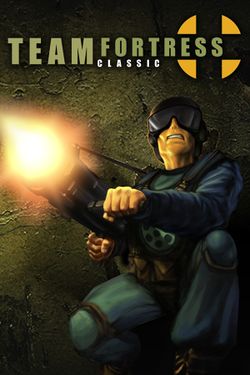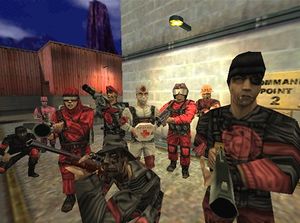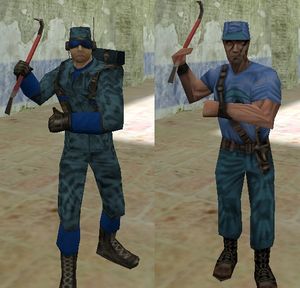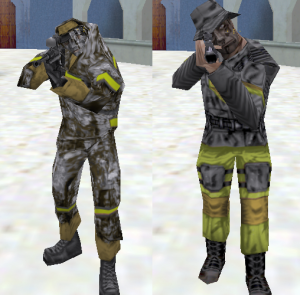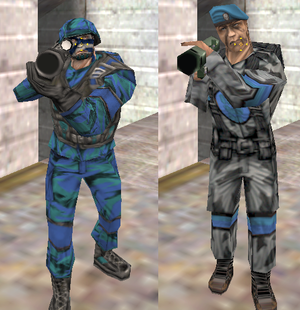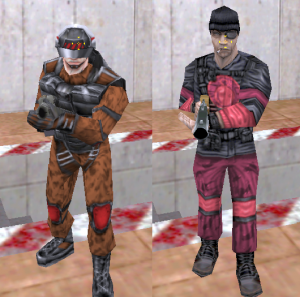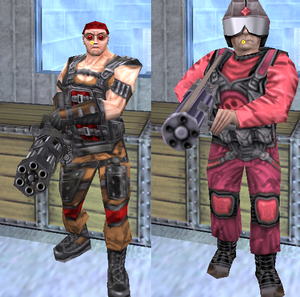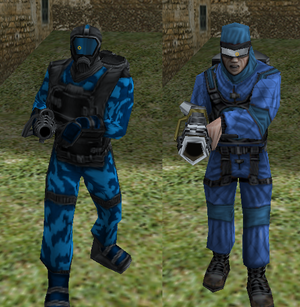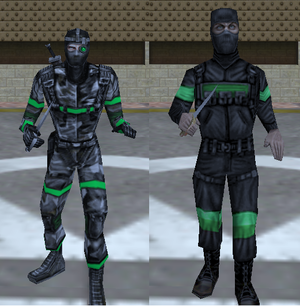Team Fortress Classic
| This article or section may need to be rewritten entirely to comply with Team Fortress Wiki's quality standards. You can help. The discussion page may contain suggestions. |
Team Fortress Classic (usually abbreviated TFC) is the predecessor of Team Fortress 2 and a port of the original Team Fortress, which was originally a mod for the popular game 'Quake', to the original Half-Life engine.
Team Fortress Classic is a team-based multiplayer first-person shooter video game developed by Valve. A remake of the Team Fortress modification for Quake, Team Fortress Classic was originally released for Windows on May 30, 1999 as a free addition to Half-Life. A standalone version was later released with Valve's Steam system in 2003. The development of Team Fortress Classic was led by John Cook and Robin Walker, the designers of the original Team Fortress modification.
The game was originally announced in 1999, powered by Valve's GoldSrc engine. The designers of the Team Fortress modification were contracted by Valve to develop Team Fortress 2, but initially remade their original work on Valve's game engine. The game itself revolves in a number of teams, each with access to nine classes, competing in a variety of scenarios such as Capture the flag, VIP protection and territorial control. In June 2000, the game underwent a significant upgrade, adding new player character models and game modes. As of 2008, the game is one of the ten most played Half-Life modifications in terms of players according to GameSpy.
Contents
Gameplay
Team Fortress Classic revolves around a number of teams competing in a variety of game modes with players selecting one of nine classes to play as. Typically, players have the choice of two equal teams, red and blue, although certain game modes allow for more than two teams with access to different classes. Each game can sustain a maximum of 32 players. The way a player acts in a game is defined by which class they select, with each class having their own strengths and weaknesses. As such, Team Fortress Classic relies heavily on teamwork between players of different classes.
Game modes
Team Fortress Classic supports numerous types of play, with distinct objectives for teams of players to pursue.
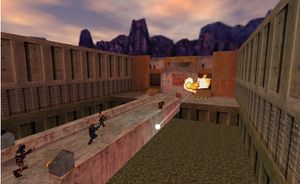
In capture the flag levels, the objective for both teams is to capture the enemy flag and return it to their base while preventing the opposing team from doing the same. Some maps of this type have twists on this formula, such as having multiple flags and requiring a team to capture them all, or requiring a team to perform a task such as disabling security grids before being able to access the flag.
Territorial control maps consist of several command points that must be captured, typically either by standing on the command point or bringing a flag to the command point. Teams are awarded points at set intervals for each command point they control.
Attack and defend maps, a variation of territorial control, feature one team trying to capture several command points in sequence, while the other team defends each command point from capture.
In escort maps, the players are split into three teams—a single VIP, the VIP's bodyguards and a group of assassins. The goal of escort maps is for the bodyguards to escort the VIP to a given point on the map, while the assassins attempt to kill the VIP before he gets there.
In an update after the game's release, a further game mode, football, was introduced. In football levels, teams must capture a single ball and take it to a capture point within the enemy base.
Classes
There are nine standard classes in Team Fortress Classic that a player can select. Each class is equipped with at least one unique weapon, and is often armed with a secondary weapon such as a Shotgun or Nailgun. In addition, all classes are armed with a melee weapon—usually a Crowbar—as well as grenades with a variety of effects depending on the class a player has chosen. In escort levels, a single player can assume the role of a civilian, armed only with an umbrella, and must be escorted by the rest of the team across the level.
Scout
- Stats:
- Max Health: 75
- Max Armor: 50 Light Armor
- Max Speed: Very Fast
- Grenades:
- Caltrop Canisters
- Concussion grenades
Sniper
- Stats:
- Max Health: 90
- Max Armor: 50 Light Armor
- Max Speed: Medium
- Weapons:
- Sniper Rifle (with automatic fire)
- Nailgun
- Crowbar
Soldier
- Stats:
- Max Health: 100
- Max Armor: 200 Heavy Armor
- Max Speed: Slow
- Weapons:
- Rocket Launcher
- Single-Barrel Shotgun
- Double-Barrel Shotgun
- Crowbar
Demoman
- Stats:
- Max Health: 90
- Max Armor: 120 Medium Armor
- Max Speed: Medium
- Weapons:
- Grenade Launcher
- Pipebomb launcher
- Single-Barrel Shotgun
- Crowbar
- Abilities:
- Can set large explosive devices.
Medic
- Stats:
- Max Health: 90
- Max Armor: 100 Medium Armor
- Max Speed: Fast
- Abilities:
- Can heal team-mates with the Medikit.
- Can infect enemies with the Medikit.
- Automatically regenerates health.
Heavy Weapons Guy
- Stats:
- Max Health: 100
- Max Armor: 300 Heavy Armor
- Max Speed: Very Slow
- Abilities:
- Heavy, isn't pushed by explosions.
Pyro
- Stats:
- Max Health: 100
- Max Armor: 150 Medium Armor
- Max Speed: Medium
- Weapons:
- Flamethrower
- Incendiary Cannon
- Single-barrel Shotgun
- Crowbar
- Abilities:
- Flame resistant.
Spy
- Stats:
- Max Health: 90
- Max Armor: 100 Light Armor
- Max Speed: Medium
- Weapons:
- Tranquilizer Pistol
- Double-Barrel Shotgun
- Nailgun
- Knife
- Abilities:
Engineer
- Stats:
- Max Health: 80
- Max Armor: 50 Medium Armor
- Max Speed: Medium
- Abilities:
- Can build automatic Sentry Guns
- Can build ammunition Dispensers
- Can repair team-mates' armor
- Can create ammunition
Civilian
- Stats:
- Max Health: 50
- Max Armor: None
- Max Speed: Medium
- Weapons:
- Umbrella
- Grenades:
- None
- Abilities:
- None
Development
Before Team Fortress Classic there was Team Fortress, a 1996 QuakeWorld mod. TF's developers were working on Team Fortress 2 as a standalone game, but later joined Valve software and ported the original as a mod for Half-Life called Team Fortress Classic in April of 1999. Despite the company's 1998 statement that Team Fortress 2: Brotherhood of Arms would be released "soon," the game remained in development of one form or another for eight years until its release on 10 October 2007, and has been on Wired magazine's top ten vaporware list every year since 2001.
Since Team Fortress Classic's release in 1999, Valve has introduced various changes into the game. The updates tweaked the game's balance and on occasion added new content, such as new levels. A particularly large update was released on 8 June 2000, which introduced several new levels and game modes, a new GUI menu interface and new player models, and optimized the game's code for smoother, faster play. With this release, the game was renamed to Team Fortress 1.5. In July 2004, the game was migrated into Valve's Steam system, in which a number of additional features were added. For much of its early history, Team Fortress Classic was second only to Counter-Strike as the most played and popular of online games.
Changes between Team Fortress 2
General TF2 additions
- All classes have unique melee weapons
- Most classes in TFC had a Crowbar. The exceptions were the Engineer (Wrench), Spy (knife), civilian (umbrella), and Medic (first aid kit).
- Overtime and sudden death modes.
- New Default maps - Granary, Hydro, Gravel Pit
- In TFC, players could only call for a Medic as their only voice command.
- Domination and Revenge
General TF2 removals
- Death counter
- TFC scoreboards listed both points and deaths (sorting by points). TF2 hides other players' death counters.
- Grenades
- Each standard class had two kinds of grenades. Generally everyone had more weapons (for example, Soldiers had two types of grenades, two types of shotguns, a Rocket Launcher, and a Crowbar). Jarate and Mad Milk are functionally similar to a Grenade, but they replace a weapon and have an effect unlike any of the grenades in TFC.
- Assassination maps
- TFC had a "VIP escort" map type where one team (typically composed of Snipers) tried to kill a player designated the civilian, who was guarded by a team of Heavies, Soldiers, and medics.
- Ammo bags
- Players left an ammo bag on the ground when they died. Players could also drop any excess ammo to help team-mates, usually Engineers. Now players drop their weapons when they die, which yields ammo and metal.
- Armor
- Players had armor in addition to health.
General TF2 changes
- Art style
- TF2's art style is cartoony, in contrast to TFC's semi-realistic style.
- Team-mates can now walk through each other
- Team-mates could not walk through each other at all in TFC, which griefers frequently exploited to block team-mates.
- Team-mates can no longer move each other with certain weapons
- Players could be pushed, or sent flying, by an explosion caused by a team-mate (or a charged Sniper Rifle). This could be exploited by griefers, used to remove griefers from an area, or used to send team-mates behind enemy lines without taking any damage.
- Warpath-style control points
- Most command point maps in TFC involved one or both teams taking flags to command points, which were then captured instantly, much like TF2's Payload game type. TF2's control points are similar to those found in the TFC map Warpath.
- 2Fort bridge is now covered.
- In TFC 2Fort's bridge is wider and uncovered.
- 2Fort's water route involved a deep swim
- In TFC, the area under the bases was completely filled with water
- 2Fort's spiral staircase and elevator
- In TFC's 2Fort, a spiral staircase led up from each team's basement, and an elevator that only worked for members of that base's team was found in the flag room's alternate entrance, forcing the use of rocket/pipe/frag/conc jumping if players wanted to exit that way.
- Dustbowl as a control point map
- TFC's Dustbowl involved moving a flag from the attacker's spawn to the capture point. Anyone who held the flag moved much more slowly (about walking speed). Captures were instantaneous.
- Dustbowl attackers always given three exits from spawn
- TFC attackers had only one or two exits in each of the stages.
- Dustbowl's secret paths now permanently open
- TFC's Dustbowl had two areas (the upper paths leading to the first two stages' CPs) that only opened after a certain amount of time had passed.
- Well as a control point map
- In TFC, Well was a capture the flag map. Well has had several significant changes, including the removal of its eponymous wells. In TFC: There were no trains, you could swim to the flag rooms (where the final CP is in the new Well) after the grates had been detpacked, the center building was much smaller and the roofs of both bases were accessible.
- Badlands as a control point map
- In TFC, Badlands was a capture the flag map that bears little resemblance to its TF2 remake. The original map featured two large bases built into the opposite sides of an even larger, winding canyon.
- Voice commands all sound different for each class
- In TFC, all classes used the same sounds while calling for a Medic.
- Unlockable weapons
- Most of the classes currently have the ability to unlock three replacement items for their weapons and tools. Some of these are similar to abilities that the classes had in TFC, but many are completely new.
Class specific changes
Scout
Removed:
- Caltrops and concussion grenades
- Caltrops were dropped on the ground to slow enemies down. Concussion grenades were largely used by Scouts and medics for 'conc jumping' and disorientating opponents.
- Nailgun
- A very accurate automatic weapon that was good against Sentry Guns and slower or stationary enemies.
- The ability to disarm a detpack by bumping into it.
- (The Demoman's detpacks were removed.)
Added:
Changed:
- Shotgun
- Replaced with the Scattergun
Soldier
Removed:
- Nail grenades
- Nail grenades fired nails for several seconds before exploding.
- Alternate fire for Rocket Launcher
- TFC alternate fire switched to the launcher and also reloaded it.
- Super Shotgun
Pyro
Removed:
- Napalm grenades
- Napalm grenades spread fire on any surfaces for a few seconds.
- Incendiary rockets
- Similar to Soldier's rockets except they did less damage but set the target (and anyone in the blast radius) on fire. Mini-rocket jumps were possible with this weapon. The Flare Gun is similar to this weapon.
Added:
Demoman
Removed:
- MIRV grenades
- These exploded once to spread several more grenades which each exploded moments later.
- Detpacks
- These not only annihilated enemies in a fairly large radius, but could also be used to break holes in certain parts of maps.
- Shotgun
Heavy
Removed:
- MIRV grenades
- Super Shotgun
Changed:
- Now called the Heavy, as opposed to 'Heavy Weapons Guy' or 'HWGuy'
Engineer
Removed:
- EMP grenades
- A dreaded grenade that caused all ordinance in a radius to explode.
- Repairing armor with a Wrench
- The Wrench in TFC could be used on team-mates to repair their armor, or to accidentally discover a disguised Spy. Armor was removed in TF2.
Changed:
- Railgun replaced with Pistol.
- Super Shotgun replaced with a standard Shotgun
- In TFC, when an Engineer had enough metal, he could instantly upgrade a Sentry Gun. In TF2, it takes eight Wrench hits to upgrade.
Medic
- Removed
- Concussion grenades
- Infection
- Medics could infect opponents with their medical kit. They could then spread the infection to their team-mates. Using the kit on a disguised Spy infected them.
- Shotgun
- Super Shotgun
Added:
- The TFC medical kit provided an instant heal whereas the new Medigun provides a continuous heal. Note that it heals disguised Spies.
Changed:
- Super Nailgun replaced with the less accurate Syringe Gun.
Sniper
Removed:
- Legshots
- A shot to the leg caused the target to run slower (like a Scout's caltrops).
Changed:
- Shot charging
- TFC Sniper rifle: Hold fire button to charge shot, release to fire. In TF2, you must stay zoomed in to charge a shot, and press to fire. Your field of vision is also severely reduced while zoomed in in TF2.
- Autorifle
- Replaced with the SMG.
Spy
Removed:
- Gas grenades
- These caused enemies to hallucinate (see and hear false explosions, flames and gunfire) for several seconds and take damage while near the grenades.
- Tranquilizer gun
- Slowed enemies down, much like caltrops and legshots.
- Nailgun
- The ability to disrupt an enemy Spy's disguise by bumping into him.
Added:
- TFC Spies could throw grenades without losing their disguise, which is how they commonly destroyed Sentry Guns. Sappers provide a replacement for this ability.
Changed:
- Cloaking replaces feign death
- Feign death ability caused the Spy to lie down (and optionally scream) to trick opponents. Spies now also have the option to use the Dead Ringer, which cloaks and drops a fake body when hit by an attack.
- Disguising time
- In TFC, disguising between classes will take more than 5 seconds per change. In TF2, it takes less than that.
- Super Shotgun
- Replaced with the Revolver
- Disguise now visible to teammates
- In TFC, disguised Spies looked like enemies to all players, including teammates. In TF2, teammates see disguised Spies like a regular Spy wearing a cheap mask of the class they're disguised as. However, even enemy Spies can now don this option.
Trivia
- On the initial page for the Engineer Update, a screenshot of the original Team Fortress Classic class models can be seen. This, as well as the Sniper's Civilian bobblehead having the Team Fortress Classic logo on its base, may indicate that Team Fortress Classic and Team Fortress 2 take place in the same universe.
- Unlike in Team Fortress 2, Team Fortress Classic contained several references (and re-used content) from Half-Life. The most striking of which was the Hunted map, instead of being a remake of the original Hunted President from Team Fortress, it was a conversion of a segment of the Half-Life campaign which involved navigating past several Sniper nests. No such official content has been made for Team Fortress 2, and in fact, one map shares a name with the original Half-Life deathmatch, but has otherwise nothing in common.
See also
External links
- Wikipedia: Team Fortress Classic
- Team Fortress Classic at the official Steam website.
- Fortress Forever
| |||||||||||
